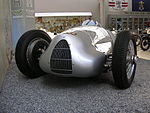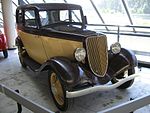Rigas motormuseum
| Rigas motormuseum Rīgas Motormuzejs | |
 Rigas motormuseum | |
| Information | |
|---|---|
| Plats | Riga, Lettland |
| Adress | Sergeja Eizenšteina iela 6 |
| Etablerat | 1989 |
| Museichef | Aivars Aksenoks |
| Antal föremål | 1 755 (2018)[1] |
| Webbplats | |
| www.motormuzejs.lv | |
Rigas motormuseum (lettiska Rīgas motormuzejs) i Riga i Lettland är det största veteranfordonsmuseet i Baltikum.[2] Museet ligger på Sergeja Eizenšteina iela 6 i stadsdelen Mežciems i den östra delen av staden. Det är statligt sedan 1992 och sorterar under Lettlands transportministerium.
Museet är sedan 1992 medlem i den internationella organisationen International Association of Transport and Communication Museums (IATM–ICOM), sedan 1994 medlem i Latvijas Muzeju Biedrība ("Lettlands museiförening") och sedan 2002 medlem i Latvijas Transporta Attīstības un Izglītības Asociācija ("Lettlands transportutvecklings- och utbildningsförbund").
Museet grundades 1989 på initiativ av den lettiska veteranbilsklubben Latvijas Antīko automobiļu klubs ("Lettlands veteranbilklubb").[3]. Byggnaden är ritad av den lettiske arkitekten Viktors Valgums.
Museet återöppnades 2 juli 2016 efter att ha varit stängt för renovering sedan 2013.
I museets kollektioner ingår bland annat en replika av Auto Unions racerbil typ D från 1938. Ett originalexemplar av fordonet från 1938 finns på Audis museum i Ingolstadt i Tyskland.[4]
Bildgalleri
- En replika av Auto Unions racerbil typ D från 1938
- Ford Köln Y från 1933
- Lettiskt byggd Ford-Vairogs V8 "De Luxe" (1938)
- Horch 830BL (1935)
- Harley-Davidson modell WL (1947)
- Moskvich 400-420
- Husqvarna 500 från 1935
- Packard Super Eight 1502 (1937)
- Lettiskt byggd RAF-2907, efter RAF-2203 "Latvija"
- Hansa G 12/36 Renntorpedo (1914)
- Selve 12/50 från 1928
Källor
- Denna artikel är delvis baserad på artikeln Riga Motor Museum på engelskspråkiga Wikipedia.
Noter
- ^ Muzeju statistika 2018 (på lettiska), Lettlands kulturministerium, Latvijas Atvērto datu portāls, läs online, läst: 18 oktober 2019.[källa från Wikidata]
- ^ Varey, Mike (2003). 1000 Historic Automobile Sites. Elderberry Press, Inc. sid. 409. ISBN 1-930859-50-3. https://books.google.com/books?id=9CCnROBrQdkC&pg=PA409&dq=%22Riga+Motor+Museum%22&num=100&sig=MSDM4iJIocmRMtRasVFgyVJz_CE
- ^ Latvijas Antīko automobiļu klubs webbplats
- ^ Audi Museum Mobiles webbplats.
Externa länkar
 Wikimedia Commons har media som rör Rigas motormuseum.
Wikimedia Commons har media som rör Rigas motormuseum.- Rigas motormuseums webbplats
- Museer i Riga på www.european-museums.com. Läst 7 april 2018.
|
Media som används på denna webbplats
Författare/Upphovsman: Liftarn, Licens: CC BY-SA 3.0
A 1935 Horch 830BL. In the 1930s Horch introduced a new line of smaller and cheaper V8 automobiles. It is powered by a 3517 cc sidevalve V8 giving 75 hp and a top speed of 115 km/h. The total weight is 1950 kg. The car in the photo ended up in USSR after WW2 where it was registered to a Red Army officer n 1945. The car was used in Vladivostok and other cities in the USSR. In the late 1980s AAK member E. Martinsons brought it from Saratov to Riga.
Författare/Upphovsman: Bengt Oberger, Licens: CC BY-SA 4.0
Husqvarna 500 racing motorcycle from 1935.
500 cc V2, 44 hp, 158 kg, max speed 162 km/h
Riga Motor MuseumFörfattare/Upphovsman: LatvianTanker, Licens: CC BY-SA 4.0
Riga Motor Museum in 2016. Rīgas Motormuzejs 2016 gadā.
Författare/Upphovsman: Liftarn, Licens: CC BY-SA 3.0
1938 Auto-Union V16 type C/D replica. This original car was purpose-bult for hillclimbing competitions. The construction was headed by Dr. Ing. Robert Eberan von Eberhorst. The car was built on a type D chassis and powered by a 520 hp supercharged 6005 cc V16 engine designed by Dr. Ferdinand Porsche. Fuel consumption was 6 litres/10 km. In 1939 Hans. Struck drove the car to victory at La Turbie in France and came second at the Grosslockner track in Austria. H. P. Müller was successful both at Grosslockner and on mountain roads in Kohlensberg aoutside Vienna. In 1945 the car was taken from Auto-Union in Zwickau to Moscow, to study it's technology. In 1976 it was at the ZIL factory in Moscow, and scheduled to be cut up for scrap metal, when Victors Kulbergs, president of the Antique Automobile Club of Latvia, acquired it as the first exhibit for the Riga Motor Museum. Audi later bought the car in exchange for money and an exact replica. In England in 1997 Crosthwhaite & Gardiner started work on restoring the original and creating the replica. The completed replica was unveiled in 2007 at the Goodwood Festival of Speed.
Författare/Upphovsman: Bengt Oberger, Licens: CC BY-SA 4.0
Selve 12/50 from 1928 in Riga Motor Museum
Författare/Upphovsman: Liftarn, Licens: CC BY-SA 3.0
A 1947 Harley-Davidson mod. WL. 739 cc V2 engine giving 25 hp and a top speed of 99 km/h. Total weight: 267 kg.
Författare/Upphovsman: Liftarn, Licens: CC BY-SA 3.0
A 1914 Hansa G 12/36 Renntorpedo. It's a two seated sports car made in Oldenburg, Germany before WW1. It is powered by a 3140 cc inline-4 giving 36 hp and a top speed of about 80-90 km/h. In this car two Germans started a journey around the world. They made it from Berlin to Moscow before the war broke out and they had to give up. The car was used by members of the Soviet government until the mid 1920s. In the beginning of the 1980s fragments of the car was found partially sunk into the ground in the gardens of the Moscow district and it was renovated by AAK member O. Orleāns.
Författare/Upphovsman: Liftarn, Licens: CC BY-SA 3.0
A 1938 Ford-Vairogs V8 "De Luxe" mod. 81A. The side valve V8 has a capacity of 3621 cc and gives 85 hp and a top speed of 130 km/h. The total weight of the car is 1493 kg.
Författare/Upphovsman: Pudelek (Marcin Szala), Licens: CC BY-SA 3.0
Moskvich 400-420
Författare/Upphovsman: Pudelek (Marcin Szala), Licens: CC BY-SA 3.0
RAF-2907, based of RAF-2203 "Latvija". Around 300 vehicles for the Olympic Games were manufactured by January 1980
Författare/Upphovsman: Liftarn, Licens: CC BY-SA 3.0
A 1937 Packard Super Eight 1502. Before WW2 it belonged to king Karol II of Romania.






















